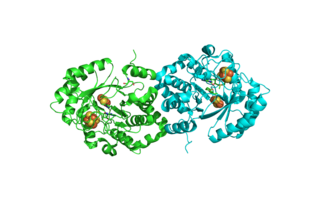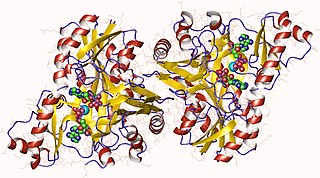
Biotin (also known as vitamin B7 or vitamin H) is one of the B vitamins. It is involved in a wide range of metabolic processes, both in humans and in other organisms, primarily related to the utilization of fats, carbohydrates, and amino acids. The name biotin, borrowed from the German Biotin, derives from the Ancient Greek word βίοτος (bíotos; 'life') and the suffix "-in" (a suffix used in chemistry usually to indicate 'forming').

3,3′-Diaminobenzidine (DAB) is an organic compound with the formula (C6H3(NH2)2)2. This derivative of benzidine is a precursor to polybenzimidazole, which forms fibers that are renowned for their chemical and thermal stability. As its water-soluble tetrahydrochloride, DAB has been used in immunohistochemical staining of nucleic acids and proteins.

Holocarboxylase synthetase deficiency is an inherited metabolic disorder in which the body is unable to use the vitamin biotin effectively. This disorder is classified as a multiple carboxylase deficiency, a group of disorders characterized by impaired activity of certain enzymes that depend on biotin. Symptoms are very similar to biotinidase deficiency and treatment – large doses of biotin – is also the same.

Biotinidase deficiency is an autosomal recessive metabolic disorder in which biotin is not released from proteins in the diet during digestion or from normal protein turnover in the cell. This situation results in biotin deficiency.
Holocarboxylase synthetase ), also known as protein—biotin ligase, is a family of enzymes. This enzyme is important for the effective use of biotin, a B vitamin found in foods such as liver, egg yolks, and milk. In many of the body's tissues, holocarboxylase synthetase activates other specific enzymes by attaching biotin to them. These carboxylases are involved in many critical cellular functions, including the production and breakdown of proteins, fats, and carbohydrates.

3-Methylcrotonyl-CoA carboxylase deficiency also known as 3-Methylcrotonylglycinuria or BMCC deficiency is an inherited disorder in which the body is unable to process certain proteins properly. People with this disorder have inadequate levels of an enzyme that helps break down proteins containing the amino acid leucine. This condition affects an estimated 1 in 50,000 individuals worldwide.
Biotinidase, also known as biotinase, is an enzyme that in humans is encoded by the BTD gene.

Biotin deficiency is a nutritional disorder which can become serious, even fatal, if allowed to progress untreated. It can occur in people of any age, ancestry, or of either sex. Biotin is part of the B vitamin family. Biotin deficiency rarely occurs among healthy people because the daily requirement of biotin is low, many foods provide adequate amounts of it, intestinal bacteria synthesize small amounts of it, and the body effectively scavenges and recycles it in the kidneys during production of urine.
Molecular binding is an attractive interaction between two molecules that results in a stable association in which the molecules are in close proximity to each other. It is formed when atoms or molecules bind together by sharing of electrons. It often, but not always, involves some chemical bonding.
In enzymology, a vinylacetyl-CoA Delta-isomerase is an enzyme that catalyzes the chemical reaction

Biotin synthase (BioB) is an enzyme that catalyzes the conversion of dethiobiotin (DTB) to biotin; this is the final step in the biotin biosynthetic pathway. Biotin, also known as vitamin B7, is a cofactor used in carboxylation, decarboxylation, and transcarboxylation reactions in many organisms including humans. Biotin synthase is an S-Adenosylmethionine (SAM) dependent enzyme that employs a radical mechanism to thiolate dethiobiotin, thus converting it to biotin.
In enzymology, a 6-carboxyhexanoate—CoA ligase is an enzyme that catalyzes the chemical reaction
In enzymology, a biotin—[acetyl-CoA-carboxylase] ligase is an enzyme that catalyzes the chemical reaction

In enzymology, a biotin carboxylase (EC 6.3.4.14) is an enzyme that catalyzes the chemical reaction
In enzymology, a biotin—CoA ligase is an enzyme that catalyzes the chemical reaction
In enzymology, a biotin-[methylcrotonoyl-CoA-carboxylase] ligase is an enzyme that catalyzes the chemical reaction
In enzymology, a biotin—[methylmalonyl-CoA-carboxytransferase] ligase is an enzyme that catalyzes the chemical reaction
In enzymology, a 8-amino-7-oxononanoate synthase (EC 2.3.1.47) is an enzyme that catalyzes the chemical reaction
In enzymology, an adenosylmethionine-8-amino-7-oxononanoate transaminase is an enzyme that catalyzes the chemical reaction
Multiple carboxylase deficiency is a form of metabolic disorder involving failures of carboxylation enzymes.






